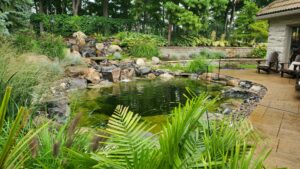Natural swimming pools and harmful pathogens?
E. coli is a type of bacteria that can cause serious health problems if ingested. It is commonly found in sewage, animal waste, and contaminated water, and can lead to symptoms such as diarrhea, cramps, and fever. While it is possible to contract E. coli from eating contaminated food, the risk of infection from swimming in contaminated water is also a real concern.
Natural swimming pools, also known as “natural pools” or “swimming ponds,” are becoming increasingly popular as an alternative to traditional chlorine-treated swimming pools. These pools use a combination of plants, gravel, and other natural materials to filter and clean the water, rather than relying on chemical treatments. However, if not designed and maintained properly, natural swimming pools can become a breeding ground for E. coli and other harmful bacteria.

One of the key factors in the design of a safe and healthy natural swimming pool is the use of properly sized ultraviolet (UV) units. UV units use UV-C light to kill microorganisms, including E. coli, in the water. The size of the UV unit is important because it needs to be able to properly treat the entire volume of water in the pool. A properly sized UV unit will ensure that the water is consistently safe and free of harmful bacteria.
It is also important to note that UV units need to be maintained and replaced regularly. The UV lamp will lose its effectiveness over time and will need to be replaced. Additionally, the quartz sleeve that surrounds the lamp should be cleaned regularly to ensure the maximum efficiency of the UV unit.
Another important aspect of natural swimming pool design is the use of a proper skimming system. This system removes floating debris and other contaminants from the surface of the water, helping to keep the pool clean and free of bacteria. The skimming system should be connected to the pump and filter system to ensure that the water is continuously circulated and filtered.
Another important factor to consider when designing a natural swimming pool is the use of appropriate materials. Some natural materials such as sand, can harbor E.coli and other harmful bacteria if there is insufficient circulation, one could consider using materials that are less likely to harbor harmful microorganisms, such as gravel or peastone.
In conclusion, natural swimming pools have become a popular alternative to traditional pools, however, it is important to understand that they also require proper design and maintenance in order to avoid the hazards of E. coli and other harmful bacteria. By using properly sized UV units, regular maintenance, and appropriate materials, natural swimming pools can be a safe and healthy alternative to traditional pools. If you’re considering installing a natural swimming pool, be sure to consult with a professional to ensure that it is designed and maintained properly to avoid the hazards of E. coli. UV units are an important part of the filtration process and if used properly, will ensure that the water in your
